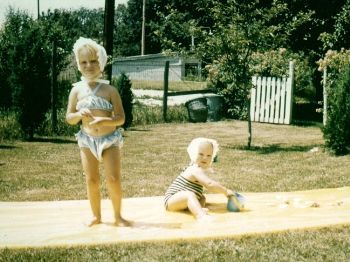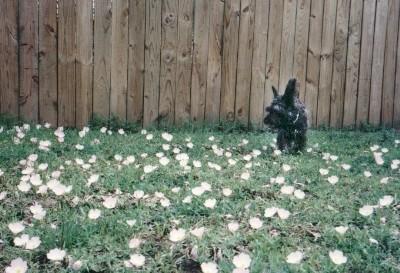
Valerie and Vicky enjoying the lawn with a Slip-N-Slide.
Joliet, Illinois, 1961
 Valerie and Vicky enjoying the lawn with a Slip-N-Slide. Joliet, Illinois, 1961 |
In our modern world, the lawn is sometimes an inappropriate conformity. Anybody who has tried to maintain a lawn in the sandy areas of the coastal plain, the rocky deserts of the Southwest, or the caliche and clay mix in our area of Texas, quickly discovers that it is not a simple process of planting seed, watching it grow, then mowing. The beautiful carpets of soft grass that grow so easily in the Midwest are simply caricatured in some areas with low growing, high-maintenance grasses that resemble weeds. A perfect example is our most common lawn grass here in central Texas: St. Augustine. I've heard of new residents trying to pull it all up, thinking they were doing away with crabgrass, which it closely resembles. This species is a pretty good substitute for a fine lawn as long as it is watered sufficiently, doesn't freeze out, doesn't succumb to disease, receives enough fertilizer, is not kept too damp, and is not shaded too much. It does fairly well in about half our lawn area.
There are concepts about lawns that are so ingrained that nobody seems to notice that they are fallacies. One is the idea of a lawn as looking so inviting that one can romp barefoot in it or lie on its soft green expanse. How many people actually walk around in their lawn barefoot? Considering that one of the major purposes of a lawn nowadays is to provide a convenient place for the family dog to take a dump without having annoying branches or prickly plants sticking it in the butt, there are things in the grass that are not welcomed between one's toes. Lie on the grass and you risk a major infestation of chiggers. Everyone in the South knows that a nice lawn is a perfect habitat for fire ants. Another assumed truth is that a perfect monoculture lawn is beautiful. It might be in a superficial way, but not to everyone. It could also be said that a newly black-topped parking lot is beautiful in its purity and simplicity. But how interesting is that same unbroken expanse when seen day after day? While I can appreciate the spectacle of endless rolling prairies, amber waves of grain, or even the expansive monotony of the surface of the open ocean, I prefer more variety when it comes to my abode and immediate surroundings.
So what purpose does a lawn serve in our current situation? I'm sure that there are as many answers to this question as individual preferences. Quite some time ago, I gave up the notion that a lawn must have only one kind of plant in order to be acceptable. As long as the plants prevent soil erosion, can endure my steps, don't produce sharp spines or clinging burrs, and don't grow very tall very fast, they are welcome. If they produce pretty flowers or interesting leaves, that is a plus. I happen to often walk barefoot in our yard, so I don't want prickly thorns lacerating my insteps. I do, however, want a lawn that is interesting.
Our lawn separates our gardens. It provides Larry with a bit of variety to his exercise regimen every time it needs mowing. Because our gardens are limited, the lawn also provides additional space for a wider variety of plants. There is one kind of small, short-lived annual grass that grows only a few inches tall. It produces lovely seed heads that resemble small feathers. I've nicknamed it "peacock grass" because of its attractive blue-green color. For a few weeks every spring, it adorns the edges of our driveway and front sidewalk. Then it dies and the brown remains all but disappear in the profusion of Bermuda, St. Augustine, and half a dozen other grasses that also grow in our yard. I also enjoy kidney grass, which isn't a grass at all but a creeping broadleaved plant. It is sometimes called pony toes because the delicate little leaves are hoof-shaped. Parts of our lawn that are in deep shade do not support grass. I've found that sedge and liriope make admirable grass substitutes for these areas and I just transplant those plants from the gardens (where they are not welcome) to the lawn. The primrose, vetches, and henbit that grow in areas of our yard all provide some welcome seasonal color.
 One of our Austin lawn's finer moments: Frisky and primrose |
While the lawn does not provide the wealth of habitat available in the average garden, a nicely diversified flora can support some interesting wildlife. Besides the plants, there is a fair selection of fungi, and the various mushrooms that sprout sporadically in our yard are always a welcome surprise. Beetles, spiders, tiny moths and butterflies, and pillbugs all inhabit our miniature plains. I often find toads out in the open areas as well. Our dog, Frisky, relishes the grubs that emerge after a heavy rain and the cicadas that surface after their long subterranean larval lives come to an end.
One of the least appreciated aspects of a lawn is weeding. I tend to use very few chemicals in our yard and so have controlled unwanted plants by simply pulling them out. When I was growing up in Illinois, pulling dandelions was a pleasant ritual best performed while chatting with other family members. Removing "weeds" has never seemed to be a chore. It is more of a pastime. Like watering, it is another excuse to get out and just observe the environment. While there used to be numerous noxious or unsightly plants in our yard, over the years their numbers have diminished substantially just because I've selectively removed those I didn't want. At times, I think the grass in some areas has done too well and it has crowded out some of my favorite wildflowers.
I'll admit that I do admire the distant perspective of our lawn when it is freshly mowed and all the different plant species blend into a uniform whole. It sets the gardens off very nicely and gives our entire yard a manicured and well-groomed look. But, upon closer inspection, the myriad flora species that constitute our lawn still have their own characteristics. They are not homogenous, the greens don't quite match, and the textures mix and mingle but don't combine. Instead, there is a diverse ecosystem beneath our feet, harboring enough tiny residents that one can imagine taking a miniature safari and meeting up with all manner of diminutive beasts. I prefer it that way.